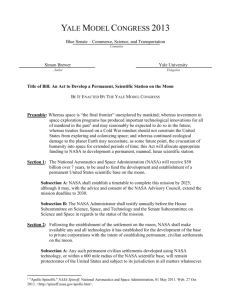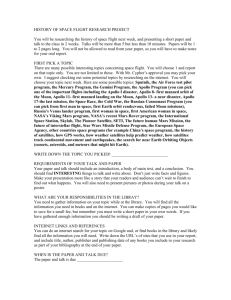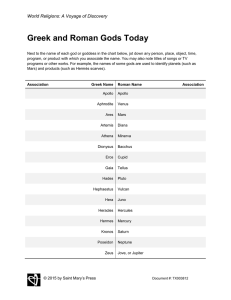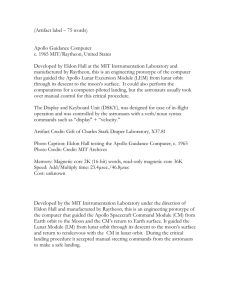A Healthy Dose of Skepticism
advertisement
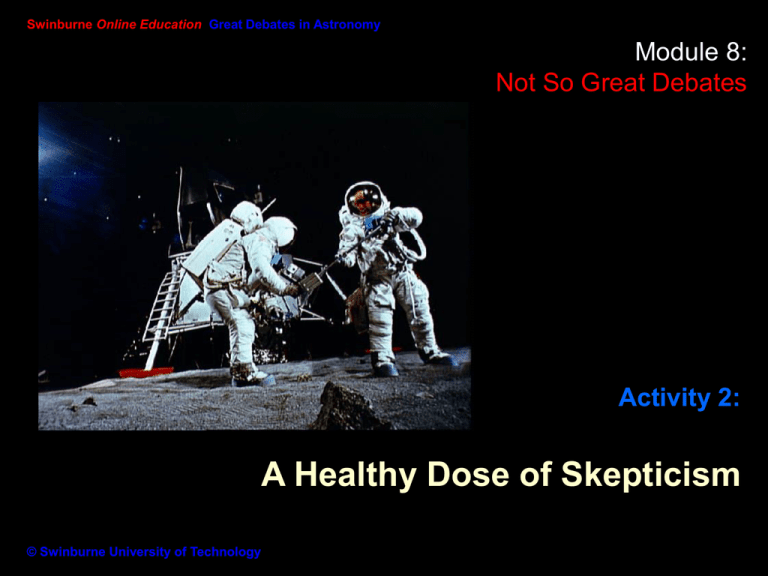
Swinburne Online Education Great Debates in Astronomy Module 8: Not So Great Debates Activity 2: A Healthy Dose of Skepticism © Swinburne University of Technology Summary In this Activity, we will look at two “fringe” theories that the majority of the scientific community have always disagreed with, but that a not-insignificant number of people believe - even when all the evidence seems to clearly point against it. We will investigate: • approaches to Skeptical Thinking; • the Moon Hoax; and • the Face on Mars. Quantity or Quality? We live in a society that is constantly bombarded by information. Newspapers Television Magazines The Internet Radio Films With this quantity of information comes a need to make a judgement about the quality, but often this judgement requires that you have some additional knowledge. When we are presented with two different views on a topic, how do we work out whether one, both or neither of the views are correct? Decisions, Decisions Consider the following scenario. You walk into a book store looking for a book on the Search for Extra Terrestrial Intelligence . You are presented with two options*: A Phoenix From the Ashes: A History of the SETI Institute Alien Encounters and Other Unexplained Phenomena Which of these books do you choose? * Reference to any existing book is purely unintentional How Do You Choose? Was your choice influenced by the fact that you have some background in astronomy and science, so that you can make an “informed” choice between these two? What if you had no astronomy background, how would you choose? In that situation, is your choice any more or less valid? What Do You Believe? In this Activity, we are going to look at two case studies where science has provided an answer that some people choose not to accept. We are going to look at evidence that: • The Moon landings were faked. • There is direct evidence for an ancient Martian civilisation. Note that in our statement above, choice is the most important element. We are not going to make any judgements about whether a person should or should not be allowed to believe either side of the argument. We will simply present the cases and the scientific evidence that refute the specific claims. Whether you believe or not is totally up to you! Taking Sides In the Great Debates we have presented so far, both the “for” and “against” arguments are quite technical: Big Bang versus Steady State One of the most important pieces of evidence for the Big Bang over the Steady State theory is the existence of the isotropic 3K microwave background radiation. This is believed to be the remnant of the decoupling of matter and photons that occurred as the “cosmic fireball” cooled. To discern between opposing viewpoints, scientists are trained to theorise and perform experiments until they can convincingly demonstrate that one of the viewpoints is absolutely ruled out. Note that this does not automatically prove that the other viewpoint is the correct one, only that it has yet to be disproved. Extraordinary Claims, Extraordinary Evidence* When presented with claims such as the faking of the Moon landings, the temptation may be to say “That’s ridiculous - how could anyone believe that!”. However, that does not stop books, television shows and numerous Internet sites arguing that these claims are not ridiculous. Drink up, it’s good for you And some people do believe them… How then should a scientist respond to “extraordinary claims”? Often the best method is with a healthy does of skepticism. * A famous quotation on skeptical thinking has been attributed to Carl Sagan: “Extraordinary claims require extraordinary evidence.” Skeptical Thinking In his book, “The Demon Haunted World” Carl Sagan offered some ideas on skeptical thinking: What skeptical thinking boils down to is the means to construct, and to understand, a reasoned argument and - especially important - to recognize a fallacious or fraudulent argument. The question is not whether we like the conclusion that emerges out of a train of reasoning, but whether the conclusion follows from the premise or starting point and whether that premise is true. Sagan suggested that a skeptic should be equipped with a set of tools for investigating claims: a “Baloney Detection Kit”. Hey, this thing does work! What Goes Into the Skeptics Toolkit? Some useful skeptical tools include the following: • Look for independent confirmation of the facts. • Experiments are more believable if they are repeatable. • Encourage debate on the evidence by knowledgable proponents of all points of view. • Do not rely upon arguments from authority, as they carry little weight. Authorities can be wrong! • In an argument, every link in the chain must work - not just most of them. More Tools: Which Hypothesis is Best? There may be more than one hypothesis to explain a claim, so try and think of (at least) a few of them. • Always ask whether each hypothesis can be falsified. • Think of tests that can disprove each alternative. • Do not get attached to a hypothesis because it is your own. • Where possible, discriminate between hypotheses by applying a numerical value that helps to quantify what you are measuring. • Apply Occam’s Razor - if two hypotheses explain the data equally well, choose the simpler one. With our toolkit in hand, we are ready to tackle the first of the case studies. The Moon Landing On 20 July 1969, astronauts Neil Armstrong and Edwin “Buzz” Aldrin left the Apollo 11 Lunar Lander and became the first humans to walk on the surface of the Moon. Or did they? The Moon Nevada? Edwin “Buzz” Aldrin Has anyone ever been to the Moon, or were Armstrong, Aldrin and the rest of the Apollo astronauts participants in the greatest hoax of the 20th century, perpetrated from a top-secret television studio in Nevada? Who Does Not Believe? Just how many people subscribe to “Moon Hoax” theories? One year after the Apollo 11 mission, a survey by Knight Newspapers of 1,721 US residents found that 30% were not totally convinced that the Moon landing was real*. Polls conducted by Time/CNN and Gallup during the 1990s suggested that around 6% of those surveyed had doubts, corresponding to ~10 million people across the US. Whatever the actual number of doubters, NASA continues to receive letters demanding to know the truth. * Like all newspaper polls, this result should also be treated with skepticism! Conspiracy Theories A selection of books supporting the view that there were conspiracies involved in the Moon landings include: • We Never Went to the Moon: America’s Thirty Billion Dollar Swindle by Bill Kaysing, Randy Reid. • NASA Mooned America by Ralph René. • Dark Moon: Apollo and the Whistle-Blowers by Mary Bennet and David S. Percy. • Moongate by Bill Brian. In February 2001, the US Fox TV network aired Conspiracy Theory: Did We Land on the Moon?, once again opening the question of Moon hoaxes. A great deal of response was generated on the Internet, with a comprehensive “debunking” carried out by Phil Plait on his Bad Astronomy web-site (www.badastronomy.com). The “conspiracy theories” seem to full into two broadcategories. • That the Moon landings were completely faked. • That missions to the Moon did occur, but the footage shown was faked in order to cover up what the astronauts really found. Most of the doubts raised about the Moon landings are based on “anomalies” primarily from the visual record: the photographs and movies actually taken by the astronauts. Armstrong, Collins and Aldrin Should Armstrong have received the Best Actor OscarTM in 1969 instead of John Wayne? Reasons Why the Landing Was Faked The following is a list of some of the “evidence” supporting the claim that the Moon landings were faked*. • There are no stars in the pictures taken on the Moon’s surface. • There is very little dust and no crater caused as the Lunar Module comes to rest. • No smoke or flames are visible when the Lunar Module takes off. • The US flag waves in the vacuum of space! Let’s have a close look at the evidence. * A more complete list may be found at the Bad Astronomy web-site. Parallel light rays from Sun No Stars in the Pictures When the Sun is above the horizon, the Earth’s atmosphere scatters light in all directions, and Scattered by atmosphere the sky appears blue*. When the Sun is below the horizon on Earth, the night sky is dark(ish) and the stars are visible. There is no atmosphere on the Moon, so the sky should always be dark as the Sun’s light is not scattered. Therefore, stars should be visible all the time on both the night and day sides of the Moon. But there are no stars in the background of images of astronauts! * The blueness of the sky is due to Rayleigh Scattering that preferentially scatters blue light about ten times more than red light. No stars The Earth above the Moon’s horizon No stars Edwin “Buzz” Aldrin descends from Apollo 11 Lunar Module No stars Charles Conrad Jr setting up equipment near Apollo 12 Lunar Module Is the lack of stars in photographs evidence that the Moon landings are a hoax? How would you respond to this claim? Response to No Stars Claim Would you expect to see any stars if you took a photograph at night of a person standing underneath a street light? No, because you would need to set your camera’s exposure to deal with the bright object that you are focusing on, and so you would miss the faint background stars. The same things happens with photographs taken on the Moon. The stars are there, but they are just too faint to be seen in photographs with the short duration exposures that were taken. The astronauts would have seen the stars with their own eyes, because the human visual system is not the same as a camera. Counter Claim But what about this picture here of the damaged Apollo 13 service module. There seem to be lots of stars in the background of this image! What’s going on? It should become apparent what the “stars” really are if you look closely at the exhaust port... Counter Claim But what about this picture here of the damaged Apollo 13 service module. There seem to be lots of stars in the background of this image! What’s going on? It should become apparent what the “stars” really are if you look closely at the exhaust port... How can stars be in front of the engine? Because they are faults in the image! No Crater and No Dust Because there is no atmosphere on the Moon, aerobraking cannot be used to control the descent, and so a significant thrust is required to slow down the Lunar Module. However, there is no evidence of a crater underneath the Lunar Module that you might expect from such a large thrust. And there does not seem to be much dust that has been disturbed by the landing either, when it should all have been blown away. Is the lack of a sizeable crater underneath and the presence of dust near the Lunar Module evidence that the Moon landings are a hoax? How would you respond to this claim? Apollo 14 Lunar Module Response to the No Crater Claim A NASA Information sheet* has this to say: “Although the descent engine of the L[unar] M[odule] is powerful, most of its operation takes place thousands of feet above the Moon during the early stages of the landing.” Unlike an asteroid or meteorite that crashes into the surface of the Moon, leaving a sizeable impact crater, the Lunar Module landing was a controlled descent. The Lunar Module engines were capable of a thrust of about 44,500 Newtons (10,000 pounds), but near the surface, this was throttled back to about 13,000 Newtons (3000 pounds). With this lower amount of thrust, a sizeable “blast” crater is much less likely. * Quote taken from article at http://www.wired.com/wired/archive/2.09/moon.land_pr.html Response to the No Dust Claim When dust is blown around on the Earth, it is because of the motion of particles in the air knocking against the dust in a very complex “conservation of momentum” situation. The distance that the dust travels depends on such things as the density of the air, the mass of the dust particles and the mass of the air molecules. Let’s demonstrate this with a simple diagram: Take a Deep Breath…and Blow! If we were to look very closely at the interaction between the air we are blowing out and the dust particles, this is what we would see: Air molecules Dust particle In this situation, the molecules in the air we breathe out push against other bits of air, which eventually strike the dust particles, providing a force that pushes the dust. And so on. However, on the airless Moon, the only way that dust can be moved around by the engine exhaust is: If the dust is directly hit by other dust particles If the dust is directly hit by the exhaust products Exhaust product Dust particle or Dust particle Dust particle These two effects will result in much less dust being displaced from the vicinity of the Lunar Module as the descent engines are fired than if the same engines were used on the Earth. Therefore, it should not be surprising that there is still plenty of dust near the Lunar Module to record the footsteps of the Apollo astronauts. And the footprints left in the dust should remain there for thousands of years, as there is no wind to blow them away. No Smoke or Flames When Lander Lifts Off When a rocket, such as a Saturn V (left), takes off it is accompanied by a great deal of smoke and flame. When the ascent stage of the Lunar Module was launched, returning the astronauts to the waiting Command Module orbiting the Moon, there was no smoke and no flames. You can follow this link to watch a movie of the Lunar Module taking off here and see for yourself that there is no smoke or flame. Is the lack of smoke and flame in the launch of the Lunar Lander ascent stage evidence that the Moon landings are a hoax? How would you respond to this claim? The Apollo 11 Lunar Lander returns to the Command Module, as seen by waiting astronaut Michael Collins Response to the No Flame Claim The fuel source for the Lunar Lander ascent stage was a mixture of the hypergolic propellants Dinitrogen Tetroxide and AeroZine (50% Hydrazine*, 50% unsymmetrical Dimethyl Hydrazine). Hypergolic means that the two chemicals will ignite when they are brought into contact with each other. This has advantages with regards to storing the propellants, and allows for easy stopping and restarting of the ignition. When brought into contact, Dinitrogen Tetroxide and AeroZine produce a product that is transparent. The reason that no flame can be seen is that there is no flame to be seen - it’s invisible. * Hydrazine is a compound of hydrogen and nitrogen, similar to ammonia. Stars and Stripes in Space “Buzz” Aldrin Apollo 11 Pete Conrad Apollo 12 Gene Cernan Apollo 17 Consider these images taken during three of the Apollo Moon landings. Let’s zoom in on the flag in each photograph. Stars and Stripes in Space “Buzz” Aldrin Apollo 11 Pete Conrad Apollo 12 Gene Cernan Apollo 17 Consider these images taken during three of the Apollo Moon landings. Let’s zoom in on the flag in each photograph. The crumpled nature of the flags make it looks like a wind is blowing through them. But how can that be, as there is no air, and definitely no wind on the Moon? More Evidence And what about the footage of Neil Armstrong and “Buzz” Aldrin planting the American flag on the Lunar surface, that you can watch by following this link. The flag clearly moves after they have let go of it. How could that be? Is the rippled appearance of the flags and the fact that the flag is actually seen to move unaided evidence that the Moon landings are a hoax? How would you respond to this claim? Response to the Waving Flag Claim Here is a picture of how the flag was meant to be deployed. While this image shows how the flag was actually transported to the Moon. You can see that the flag material is folded up, and that the flagpole consists of several segments. The reason the first flag planted on the Moon appears to have ripples is that it did not deploy as planned! Broken Flag Failure At the top of the flag is a telescoping support rod that was designed to stretch the flag material out smoothly. Unfortunately, Armstrong and Aldrin were not able to get the support aim to extend complete. Just like a shower curtain that is not fully stretched out, the material was left in a crumpled state. The Apollo astronauts liked the effect so much, that they deliberately did not extend the horizontal rod on the later flights. And another piece of the flag system failed for Apollo 12, when they could not get the horizontal rod to latch properly, so that the support structure was left drooping. The Flag in Motion That might explain why the flag appears to be crumpled, but what about the motion seen in the movie of the Apollo 11 flagraising ceremony? Horizontal rod The three components of the flag shown here are all connected to each other. That means if you shake or twist any one of them, a wave will propagate through the others and they will also start to move. Flag Flagpole The amplitude of this wave will be damped by friction at the joints, and at the point where the flagpole is planted into the ground. On Earth, this motion is also damped by air resistance. The Flag in Motion If you go back and watch the movie again, you will see that one of the last things that Neil Armstrong* does once the flag is in place is to give it a bit of a push. Horizontal rod Flag Flagpole * Armstrong then walks further away from the flag leaving Aldrin to salute the flag, as shown in the image we used earlier. The Flag in Motion If you go back and watch the movie again, you will see that one of the last things that Neil Armstrong* does once the flag is in place is to give it a bit of a push. The flag oscillates briefly, but you can see that the amplitude is already starting to be damped by the time Aldrin is ready for his photograph. There is one final piece of evidence that would actually add support to the claim about the waving flag…if it could be found: Horizontal rod Flag Amplitude of oscillation decreases Flagpole * Armstrong then walks further away from the flag leaving Aldrin to salute the flag, as shown in the image we used earlier. Blowing in the Wind If there was a wind strong enough to blow the flag, then surely that wind would also be able to blow dust around? However, none of the Moon Hoax supporters seem to have proposed that the evidence for this exists... That dust will never move now! And neither will Neil nor Buzz… You can read more about the issues surrounding the planting of the United States flag on the Moon at: http://spaceflight.nasa.gov/mars/reference/flag/flag.html .. Weighing up the Evidence We have now looked at some of the evidence presented to support the view that the Moon landings were faked: • No stars in the pictures. • Little dust and no crater as the Lunar Module lands. • No smoke or flames as the Lunar Module takes off. • The US flag waves in the vacuum of space. In each case, it was possible to apply an alternative hypothesis based on physical principles. Were the hundreds of people who contributed to one of the greatest scientific and exploratory endeavours of human history merely pulling the wool over the eyes of the rest of the population of Earth, or did NASA really send 12 astronauts to the Moon and return them safely? What do you believe? Want to Know More? To read more about the Moon Hoax, visit these web-sites: • An article in Wired Magazine • “Crank.net”: http://www.crank.net/apollo.html • Some fun Apollo images: http://www.hq.nasa.gov/alsj/alsj.funpix.html Apollo astronauts train in a studio for their trip to the Moon. The Mars Mystery Having left the Moon behind, it is time to move onto the next case study. On July 25th, 1976, the Viking Orbiter 1 was searching for Viking Orbiter potential landing sites for Viking Lander 2. One of many photographs taken on that day was of a region of buttes and mesas in the northern hemisphere near coordinates 40.8° N, 9.6° W, known as Cydonia. Viking Lander North Olympus Mons East West 40.8° N, 9.6° W Mariner Valley South The Cydonia region was photographed from a height of 1873 kilometres (1162 miles) above the surface, with a resolution of about 43 metres (140 feet) per pixel. This image was catalogued as 35A72 (or P-17384). It is shown here in its “raw” form. The mission scientists spotted an interesting looking feature. Can you? It might be more obvious if you look at the image after some image processing has taken place... This image was catalogued as 35A72 (or P-17384). It is shown here in its “raw” form. The mission scientists spotted an interesting looking feature. Can you? It might be more obvious if you look at the image after some image processing has taken place... 35A72 (P-17384) A press release on July 31, 1976 from the NASA Viking News Center had this to say about 35A72 (P-17384): The picture shows eroded mesa-like landforms. The huge rock formation in the center, which resembles a human head*, is formed by shadows giving the illusion of eyes, nose and mouth. The feature is 1.5 kilometers (one mile) across, with the sun angle at approximately 20 degrees. The speckled appearance of the image is due to bit errors, emphasized by enlargement of the photo. * Emphasis added Producing the Image A great deal of processing goes into producing an image like this. The image was clipped, rotated, magnified by a factor of three, and contrast enhanced. For example: magnify enhance contrast clip rotate The final image appears quite blocky because a “lossy” compression scheme has been used. We will look at one particular processing technique in a few slides... A Trick of the Light? I know what this is! It’s the face of modern astronomy! The human visual system is adept at picking out shapes that look recognisable from almost any pattern, and this recognition system is optimised for identifying faces. The JPL press release was up-front in suggesting that the “Face” was due to shadows. But that didn’t stop some people from suggesting that the Face was an enormous monument constructed by an ancient Martian civilisation. Or a Martian Civilisation? Along with the Face, there were a flood of images that were processed to show: • A set of 4 Martian “pyramids” in the Elysium Planitia; • A “pyramid” perched on the edge of a crater; • A grid-like formation of cells called “The Inca City”’; and so on. Often the names for these features (like “The Face”) were suggested by the NASA scientists who discovered them as simple descriptions of what they looked like. The names were later attributed some kind of “real” meaning to provide evidence that the Civilisation had been active in its building campaign. The Monuments of Mars One of the chief proponents of the Martian Civilisation theory has been Richard C. Hoagland, author of “The Monuments of Mars: A City on the Edge of Forever” (1987)*. Over 15 years earlier, Hoagland, along with Eric Burgess, had realised that the planned Pioneer 10 and 11 spacecraft would ultimately leave the Solar System. They suggested to Carl Sagan that a message should be attached to these two spacecraft, resulting in the preparation of the Pioneer Plaque, discussed in the SAO Unit Introductory Radio Astronomy & SETI. * Now in its 5th edition as of September 2001. Hoagland’s web-site is: http://www.enterprisemission.com First work Many of Hoagland’s, and other author’s, contentions are based on the “pioneering” work on the Face undertaken by Gregory Molenaar and Vince DiPietro. During the late 1970s, Molenaar and DiPietro were working as contract programmers to NASA at the Goddard Space Flight Centre. After seeing copies of the Face photographs, they decided to see if they could improve the image quality. In 1980, they set to work developing an image processing algorithm known as SPIT: Starburst Pixel Interleaving Technique. They worked on the project after hours, using borrowed NASA equipment. A total of 10 images of the Face were available... How SPIT Works For each complete Viking image, there were 1204 pixels for each of the 1056 lines, with the Face covering a much smaller number of pixels than this. Every pixel is a shade of grey. Consider a small part of the image covering 3x3 pixels. Each pixel can be black, white, or a shade of grey somewhere in between. What SPIT does initially is subdivide each pixel into 9 smaller pixels. The grey-scale values for these new pixels are determined by the values of adjacent pixels. How SPIT Works The original range of grey scale values was between 60 and 108. 255 = white Grey-108 Grey-60 0 = black How SPIT Works The original range of grey scale values was between 60 and 108. This was stretched out over a much larger range to increase the contrast in the images. 255 = white Grey-108 Grey-60 0 = black Additional enhancement was used in order to highlight slight changes between nearby pixels that were almost the same shade of grey. This is similar to an edge detection algorithm. Processing the Results DiPietro and Molenaar published their results in a document called Unusual Martian Surface Features, and presented their results at the June 1980 meeting of the American Astronomical Society. They suggested that their image processing had highlighted the existence of an eye-ball within the eye-socket, and evidence for a second eye so that the Face was symmetric. The results of SPIT or any other image processing technique must be approached with caution, as often they do not actually introduce any new information. Instead, they enhance some features (that our visual system is then able to interpret more easily) at the expense of others. Where to Next What was really needed was a higher resolution image, and one where the dominant features were not due to the strong shadows. That higher resolution image was to arrive in 1998, with the successful Mars Global Surveyor mission (following some spectacular failures of probes such as the Soviet Phobos 1 and 2, and NASA’s Mars Orbiter). And here is what Mars Global Surveyor photographed on 5 April 1998: Without the shadows, and the improved resolution, can you still see the Face? Note that this image is slightly stretched and distorted as it was not taken from exactly the same height and orientation as the original. Not the End of the Story It appeared that the Face really was just a trick of the shadows. Unfortunately, the new image did not satisfy all of the artificial Face proponents, as it had also undergone a level of processing. There were suggestions of further conspiracies and coverups, filling many Internet sites. An even higher resolution image was taken by Mars Global Surveyor on 8 April, 2001*. * For details, visit: http://mars.jpl.nasa.gov/mgs/msss/camera/images/moc_5_24_01/face/index.html July 1976 In the the most recent of the three images, it is possible to see several of the features which coincide with the eyes, nose and mouth of the original Face. However, it is unlikely that an advanced civilisation was needed to construct this otherwise unremarkable surface feature. April 1998 April 2001 But just like the Moon Hoax, it comes down to a question of what you choose to believe. The Other Face on Mars On March 1999, the Mars Orbital Camera on Mars Global Surveyor took this photograph of the Galle Crater in the Argyre Planitia. For obvious reasons it is know as the Happy Face Crater. There do not seem to be any suggestions that this is an artificial monument…yet. Diameter: 215 km (134 miles) The End In this Activity, we have looked at two case studies where extraordinary claims have been made: • That the Moon landings were a hoax; and • That there is an artificial Face constructed by an ancient race of Martians. When these claims are held up to skeptical scrutiny, they do not hold as completely satisfactory hypotheses - particularly in the face (sorry!) of new evidence. However, no matter how hard scientists have tried, these are two not-so-great debates that just don’t seem to go away. This brings the SAO Unit Great Debates in Astronomy to an end…except for a final word from the author of this Activity. Confessions of an SAO Author I have to admit that while researching this Activity, I was quite often astounded and highly amused by some of the “Conspiracy” web-pages I encountered on the Internet. Am I of guilty of hypocrisy by suggesting that science and skeptism should work one way, but not applying the same “toolkit” myself? Perhaps. Recently after presenting a public talk that touched on such topics as the formation of galaxies, and the distribution of dark matter within the Universe, a member of the audience asked me whether I believed in what I was saying. My response was: • That I had sufficient confidence in the ideas to present them to a public audience. • That as a scientist, I should only “believe” in these theories as far as they stand up to rigorous testing, and that if a future observation clearly falsified the existence of dark matter, etc., I would be quite happy to move on to the next theory. • That I wasn’t just a trained scientist - I was also a person, and therefore should be allowed to think and believe almost anything I wanted! What do you believe? Image Credits NASA: Buzz Aldrin walks on surface on Moon during Apollo 11 EVA http://spaceflight.nasa.gov/gallery/images/apollo/apollo11/html/as11_40_5903.html NASA: Official photo of Apollo 11 prime crew - Armstrong, Collins and Aldrin http://spaceflight.nasa.gov/gallery/images/apollo/apollo11/html/s69_31740.html NASA: Apollo 11 Lunar Module takeoff http://images.jsc.nasa.gov/images/pao/AS11/10075283.jpg NASA: View of rising Earth about five degrees above the Lunar horizon http://images.jsc.nasa.gov/images/pao/AS8/10074963.jpg NASA: Buzz Aldrin descends from the Apollo 11 lander http://spaceflight.nasa.gov/gallery/images/apollo/apollo11/html/as11_40_5868.html NASA: Charles Conrad Jr, Apollo 12 http://spaceflight.nasa.gov/gallery/images/apollo/apollo12/html/as12-47-6988.html NASA: Exterior view of damaged Apollo 13 Service Module http://images.jsc.nasa.gov/images/pao/AS13/10075514.jpg NASA: Footprints near the Apollo 11 Lunar Module http://spaceflight.nasa.gov/gallery/images/apollo/apollo11/html/as11_40_5902.html Image Credits NASA: Apollo 14 Lunar Module http://images.jsc.nasa.gov/images/pao/AS14/10075610.jpg NASA: Launch of Apollo 11/Saturn V http://images.jsc.nasa.gov/images/pao/AS11/10075233.jpg NASA: Apollo 11 Lunar Module Ascent Stage http://spaceflight.nasa.gov/gallery/images/apollo/apollo11/html/as11_44_6626.html NASA: Exterior view of damaged Apollo 13 Service Module http://images.jsc.nasa.gov/images/pao/AS13/10075514.jpg NASA: Astronaut Buzz Aldrin after planting a U.S. flag on the lunar surface http://www.hq.nasa.gov/alsj/a11/as11-40-5874.jpg NASA: Broken Flag from Apollo 12 with Pete Conrad http://www.hq.nasa.gov/alsj/a12/as12-47-6897.jpg NASA: Astronaut Gene Cernan salutes the U.S. flag on the Moon http://images.jsc.nasa.gov/images/pao/AS17/10075952.jpg NASA: Tests of the US Flag for the Moon http://images.jsc.nasa.gov/images/pao/AS11/10075189.jpg Image Credits NASA: Lunar Landing Simulation http://images.jsc.nasa.gov/images/pao/AS11/10075214.jpg NASA NSSDC Photo Gallery: Viking Orbiter http://nssdc.gsfc.nasa.gov/image/spacecraft/viking_orbiter.jpg NASA NSSDC Photo Gallery: Viking Lander http://nssdc.gsfc.nasa.gov/image/spacecraft/viking_lander.jpg NASA Laboratory for Terrestrial Physics: Shaded Mars Surface Map http://ltpwww.gsfc.nasa.gov/tharsis/mercatsmall.gif NASA NSSDC Photo Gallery: Raw Viking Image 035A72 http://nssdc.gsfc.nasa.gov/image/planetary/mars/f035a72_raw.jpg NASA NSSDC Photo Gallery: Processed Viking Image 035A72 http://nssdc.gsfc.nasa.gov/image/planetary/mars/f035a72_processed.jpg NASA/JPL: Face on Mars Press Release Photograph http://science.nasa.gov/headlines/images/cydonia/pio_med.gif Face on Mars Processed Image: NASA NSSDC Photo Gallery http://nssdc.gsfc.nasa.gov/image/planetary/mars/face.jpg Image Credits Viking image of Cydonia region (f035a72): http://nssdc.gsfc.nasa.gov/planetary/image/f035a72_strip.gif Mars Global Surveyor image of Face (5 April 1998) http://nssdc.gsfc.nasa.gov/image/planetary/mars/mgs_cydonia1_processed.jpg NASA: Mars Global Surveyor image of Cydonia region http://nssdc.gsfc.nasa.gov/planetary/image/cydonia1.gif Mars Global Surveyor image of Face (8 April 2001) http://nssdc.gsfc.nasa.gov/planetary/image/mgs_cydonia3.jpg Happy Face Crater: NASA/JPL http://mars.jpl.nasa.gov/mgs/msss/camera/images/3_11_99_happy/moc2_89_msss.jpg Movie Credits NASA: Apollo 11 astronauts Neil Armstrong and Buzz Aldrin set up the American flag on the Moon's surface. http://spaceflight.nasa.gov/gallery/video/apollo/apollo11/html/lunar_activities.html NASA: The Apollo 11 Lunar Module ascends from the lunar surface. http://spaceflight.nasa.gov/gallery/video/apollo/apollo11/html/lunar_activities.html End of Unit Press the ESC (Escape) key to return to the home page for this Module.

